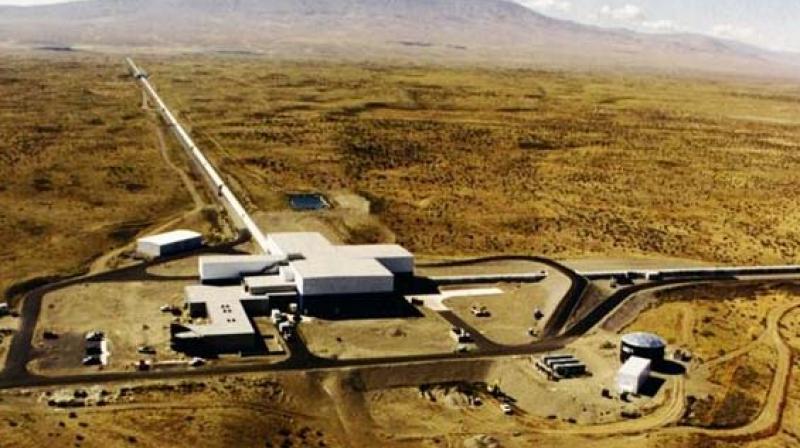LIGO-India Project
2020 FEB 26
Mains >
Science and Technology > Global research projects & India > Global research projects and India

WHY IN NEWS?
A Laser Interferometer Gravitational-wave Observatory (LIGO) is being built at Hingoli district in Maharashtra. It is expected to be operational by 2025.
LIGO-India
- LIGO-India project is envisaged as an international collaboration between the LIGO Laboratory and three lead institutions in the IndIGO consortium: Institute of Plasma Research (IPR) Gandhinagar, Inter University Centre for Astronomy and Astrophysics (IUCAA), Pune and Raja Ramanna Centre for Advanced Technology (RRCAT), Indore.
|
Indian Initiative in Gravitational-wave Observations (IndIGO), is an initiative to set up advanced experimental facilities with appropriate theoretical and computational support for a multi-institutional Indian national project in gravitational-wave astronomy. The current major IndIGO plans on gravitational-wave astronomy relate to the LIGO-India project.
|
- LIGO-India is a planned advanced gravitational-wave observatory to be located in India as part of the worldwide network. It is planned as a collaborative project between a consortium of Indian research institutions and the LIGO Laboratory in the USA, along with its international partners Australia, Germany and the UK.
- The Laser Interferometer Gravitational-wave Observatory (LIGO) project operates three gravitational-wave (GW) detectors. Two are at Hanford in the state of Washington, north-western USA and one is at Livingston in Louisiana, south-eastern USA.
- Currently these observatories are being upgraded to their advanced configurations (called Advanced LIGO).
- The proposed LIGO-India project aims to move one Advanced LIGO detector from Hanford to India.
- The LIGO-India Project will be piloted and overseen by Department of Atomic Energy (DAE) and Department of Science and Technology (DST).
- LIGO lab would provide the complete design and all the key detector components. Indian scientists would provide the infrastructure to install the detector at a suitable site in India and would be responsible for commissioning it.
- The proposed observatory would be operated jointly by IndIGO and the LIGO-Lab and would form a single network along with the LIGO detectors in USA and Virgo in Italy.
A look in to LIGO
- It was launched as a joint project between MIT, Caltech and other universities.
- LIGO stands for Laser Interferometer Gravitational-Wave Observatory. LIGO consists of a pair of huge interferometers, each having two arms which are 4 km long.
- Interferometers work by merging two or more sources of light to create an interference pattern which can be measured and analyzed. The interference patterns generated by interferometers contain information about the object or phenomenon being studied.
- Remarkable precision is needed to detect a signal as faint as a gravitational wave and the two LIGO detectors work as one unit to ensure this.
- Gravitational signals were first detected on Earth in September 2015 by the observatories located at Hanford and Livingston. Forty Indian scientists were part of this key discovery and even bagged the Nobel Prize for Physics in 2017.
|
Other major Gravitational-Wave detectors
- VIRGO is a 3km detector located in Cascina near Pisa, Italy. Virgo was designed and built by a collaboration between the French Centre National de la Recherche Scientific (CNRS) and the Italian Istituto Nazionale di Fisica Nucleare (INFN).
- GEO600 is a 600m long gravitational wave interferometer situated between Hannover and Hildesheim in Germany. GEO600 was jointly constructed by Germany and the UK.
- KAGRA (Kamioka Gravitational-Wave Detector) otherwise Large-scale Cryogenic Gravitational wave Telescope is a project of the gravitational wave studies group at the Institute for Cosmic Ray Research of the University of Tokyo.
|
Benefits of the Project
- Adding a new detector to the existing network will increase the expected event rates and can increase the sensitivity of the network. Observations from a new detector in a far-off position will help locate the source of the gravitational waves more accurately.
- Signatures of gravitational waves bouncing off celestial objects can help us detect and map them.
- It will help Indian scientific community to be a major player in the emerging research frontier of gravitational-wave astronomy.
- The nature of the experiment is intrinsically multidisciplinary, which will bring together scientists and engineers from different fields like optics, lasers, gravitational physics, astronomy and astrophysics, mathematics and various branches of engineering.
- The high-end engineering requirements of the project will provide unprecedented opportunities for Indian industries for collaboration with academic research institutions.
- LIGO project has facilitated major industry-academic research partnerships in USA and Europe and has produced several important technological spin offs. LIGO-India can provide similar opportunities to Indian industry.
- As the project involves high technology instrumentation and huge scale it can spur interest in students and young scientists in experimental physics and engineering physics.
Practice Question
Q. A Laser Interferometer Gravitational-wave Observatory (LIGO) is being built in Maharashtra. What are the potential benefits for India from the project?
